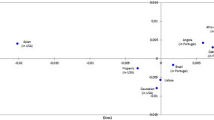Abstract
A study of VNTR polymorphism and molecular structure of 3′-UTR of the dopamine transporter gene (DAT1/SLC6A3) was performed in the Hadza and Datoga males. It was shown that Hadza and Datoga differed in allele and genotype frequencies. Allele with 9 repeats in 3′-UTR, as well as the DAT1 homozygous genotype 9/9, is more common in the Hadza. The allele with ten repeats, as well as the homozygous phenotype 10/10, is more common in the Datoga. Molecular structure of DAT1 alleles with 3, 8, and 12 repeats was determined for the first time. In addition, it was found that the DAT1 allele with 11 repeats in the Datoga significantly differed in the type and arrangement of repeats from those previously described in other populations. We suggest that variations in the repeats number and type in the 3′-UTR of allelic variants may affect the dopamine transporter gene function.
Similar content being viewed by others
References
Aksenova M.G., Golimbet V.E., Alfimova M.V., Trubnikov V.I., Ab O.V., Yazykov K.G., Nosikov V.V. 2000. Allele polymorphism of the dopamine transporter gene in patients with endogenous psychoses: Association with pathological syndromes. Mol. Biol. (Moscow). 34, 601–605.
Alfimova M.V., Trubnikov V.I. 2000. Psychogenetics of aggressiveness. Vopr. Psikhol. 6, 112–122.
Golimbet V.E., Korovaitseva G.I., Brusov O.S., Faktor M.I., Ganisheva T.K., Dmitriev D.A. 2010. The functional state of the serotonergic system and the 5-HTTLPR polymorphism of the serotonin transporter gene in patients with schizophrenia. Mol. Biol. (Moscow). 44, 223–227.
Craig I.W., Halton K.E. 2009. Genetics of human aggressive behaviour. Hum. Genet. 126, 101–113.
Ebstein R.P., Israel S., Chew S.H., et al. 2010. Genetics of human social behavior. Neuron. 65, 831–844.
De Neve J.-E., Mikhaylov S., Dawes C.T., et al. 2013. Born to lead? A twin design and genetic association study of leadership role occupancy. The Leadership Quarterly. 24, 45–60.
Kim Y.-K. 2009. Handbook of Behavior Genetics. NY: Springer.
Iversen L.L. 1971. Role of transmitter uptake mechanisms in synaptic neurotransmission. Br. J. Pharmacol. 41, 571–591.
Vandenberg D.J., Percico A.M., Hawkins A.L., et al. 1992. Human dopamine transporter gene (DAT1) maps to chromosome 5p15.3 and displays a VNTR. Genomics. 14, 1104–1106.
Donovan D.M., Vandenbergh D.J., Perry M.P., et al. 1995. Human and mouse dopamine transporter genes: Conservation of 5′-flanking sequence elements and gene structures. Mol. Brain Res. 30, 327–335.
Fuke S., Suo S., Takahashi N., et al. 2001. The VNTR polymorphism of the human dopamine transporter (DAT1) gene affects gene expression. Pharmacogenomics J. 1, 152–156.
Vasilyev V.A. 2011. Molecular psychogenetics of deviant aggressive behavior in humans. Russ. J., Genet. 47(9), 1023–1032.
Butovskaya M.L., Drambyan M.Yu., Burkova V.N., et al. 2008. Why the Hadza of Tanzania are still huntergatherers. In: Polevye issledovaniya Instituta etnologii i antropologii RAN, 2006 (Field Research at the Institute of Ethnology and Anthropology, Russian Acaremy of Sciences, 2006), pp. 38–62.
Butovskaya M.L., Burkova V.N. 2009. Child inclusion and seclusion as the rites of passage in the Datoga of northern Tanzania. Etnogr. Obozr. 2, 51–67.
Vasilyev V.A., Martirosyan I.A., Shibaev D.V., Kulikov A.M., Lazebny O.E., Burkova V.N., Ryskov A.P., Butovskaya M.L. 2011. Polymorphism of the dopamine D4 receptor (DRD4) and serotonin transporter (5-HTTL) gene promoter regions in African tribes of Hadza and Datoga. Russ. J. Genet. 47(2), 226–229.
Butovskaya M.L., Vasilyev V.A., Lazebny O.E., et al. 2012. Aggression, digit ratio, and variation in the androgen receptor, serotonin transporter, and dopamine D4 receptor genes in African foragers: The Hadza. Behav. Genet. 42, 647–662.
Kang A.M., Palmatier M.A., Kidd K.K. 1999. Global variation of a 40-bp VNTR in the 3′-untranslated region of the dopamine transporter gene (SLC6A3). Biol. Psychiatry. 46, 151–160.
Chen T., Blum K., Mathews D., et al. 2007. Preliminary association of both the dopamine D2 receptor (DRD2) [Taq1 A1 allele] and the dopamine transporter (DAT1) [480 bp allele] genes with pathological aggressive behavior, a clinical subtype of Reward Deficiency Syndrome (RDS) in adolescents. Gene Ther. Mol. Biol. 11, 93–112.
Author information
Authors and Affiliations
Corresponding author
Additional information
Original Russian Text © E.M. Sukhodol’skaya, V.A. Vasil’ev, D.V. Shibalev, O.I. Shcherbakova, A.M. Kulikov, O.E. Lazebny, D.A. Dronova, M.L. Butovskaya, A.P. Ryskov, 2014, published in Molekulyarnaya Biologiya, 2014, Vol. 48, No. 2, pp. 295–299.
Rights and permissions
About this article
Cite this article
Sukhodol’skaya, E.M., Vasil’ev, V.A., Shibalev, D.V. et al. 3′-UTR polymorphism of dopamine transporter gene in Hadza and Datoga males. Mol Biol 48, 254–257 (2014). https://doi.org/10.1134/S0026893314020174
Received:
Accepted:
Published:
Issue Date:
DOI: https://doi.org/10.1134/S0026893314020174



